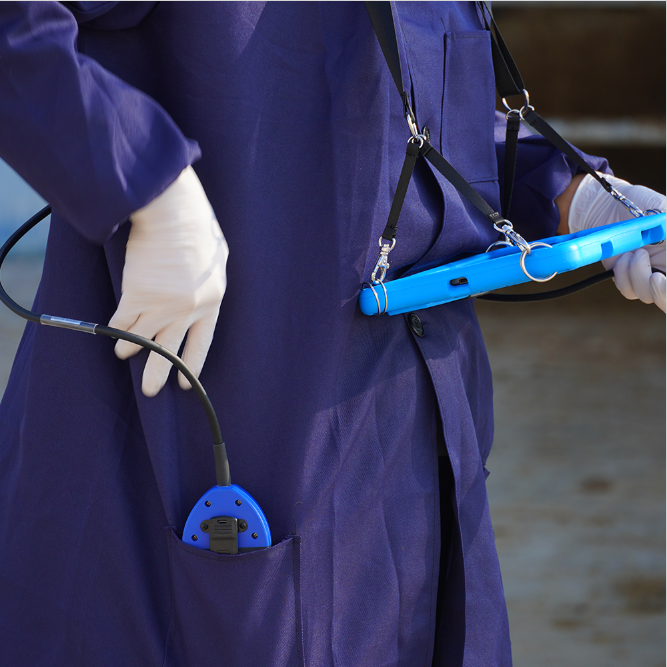When satisfactory results cannot be obtained under natural breeding conditions, the reproductive cycle of sheep can be artificially manipulated by veterinary ultrasound machines.

Veterinary ultrasound Imaging Hormonal Control: The common method of inducing estrus in non-cycling ewes is progesterone-based therapy. Progesterone prevents ewes from returning to estrus and ovulation. It is produced by the corpus luteum (CL) of the ovary after ovulation and maintains pregnancy. When progesterone is introduced artificially, they trick the body into thinking it is pregnant and the animal will not ovulate or go into estrus (heat. When the source of progesterone is completely removed, the body realizes it is no longer pregnant and will ovulate at a very predictable period. Progestogens refer to synthetic compounds that have the properties of progesterone. These substances mimic the function of CL. Progestogens (synthetic analogs of progesterone) can be delivered by feeding (MGA), subcutaneous implants (Synchro-Mate B?), sponges (or pessaries) inserted into the vagina, or plastic delivery devices (CIDRs) inserted into the vagina.
Intravaginal sponges (or pessaries) have been the traditional method of inducing and/or synchronizing estrus in ewes. They contain progesterone at a lower dose than natural progesterone. Two types of sponges are Chronogest (FGA) and Veramix? (MAP). Intravaginal sponges are usually inserted for 9 to 19 days and are used in conjunction with PMSG, which is injected at the time of sponge removal or 48 hours before sponge removal. Intravaginal sponges have a high retention rate (> 90%), and females typically show estrus 24 to 48 hours after removal. Responses to the intravaginal sponge vary, depending on breed, protocol, co-handling, management, and mating system. The CIDR™ (controlled internal drug release) device is made of a medical silicone elastomer impregnated with progesterone and was developed in New Zealand. Protocols for using the CIDR™ device are generally the same as those for the intravaginal sponge. Studies have shown that the CIDR™ device and the intravaginal sponge produce similar results. The CIDR™ device was recently approved for use in sheep in the U.S. Synchro-mate-B™ is a bovine implant containing 6 mg of synthetic progesterone. One-third or one-half of the Synchro-mate-B™ implant is typically used in ewes. The implantation period is 9 to 14 days. An injection of PMSG and/or PGF2a is typically given two days before the end of the implantation period.
An orally active synthetic progestin used to suppress estrus in heifers on feed. Use of this product requires feeding a supplement containing MGA® once or twice daily for 8 to 14 days. Regimens typically include co-treatment with PMSG, PG600®, or Ralgro® (zeranol). Ralgro® is a commercially available growth promoter for cattle and sheep that has estrogen-like effects on LH and FSH concentrations. It is the only veterinary grade source of PMSG available in the United States. The response of estrus to MGA feeding as detected by veterinary ultrasound varies but is generally higher with co-treatment. Prostaglandin-based regimens are only suitable for cycling ewes and are limited to use during the breeding season. Two commonly used products are Lutalyse® (PGF2a) and Estrumate® (cloprostenol). Prostaglandins cause regression of the CL, telling the body than no pregnancy exists. The ewes will ovulate at a very predictable time. When a flock of cycling ewes is given a single prostaglandin treatment, 60% to 70% of the flock will begin synchronized estrus 30 to 48 hours later. A double injection system (11 days apart) is most common in sheep. Melatonin Melatonin treatment has been shown to be an effective method for inducing estrus in non-cycling ewes. Melatonin is known as the "darkness hormone" because it is released by the pineal gland at night. Therefore, melatonin treatment simulates the short fall day and induces estrus after a minimum of about 35 days of treatment. It is important to note that most of the above drug treatments have been approved by the U.S. Food and Drug Administration for use in sheep, although they may be available to producers in other countries. Light Control Controlled lighting can be used to initiate estrus. Short-day breeders like sheep can be programmed to cycle if they are kept in a light-tight building, with ewe breeding tapering off over a period of 8 to 12 weeks. Rams should be exposed to the same light regiment for high fertility. Light control is usually impractical for most producers.
tags: veterinary ultrasound machinesveterinary ultrasound


